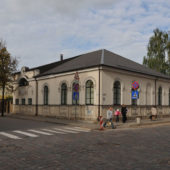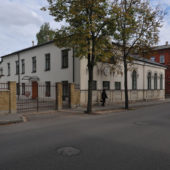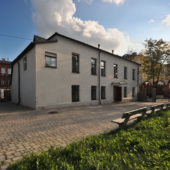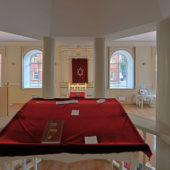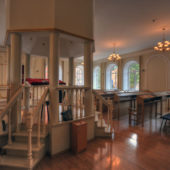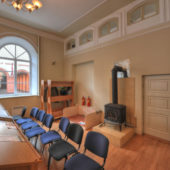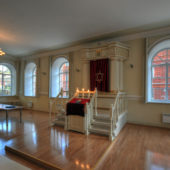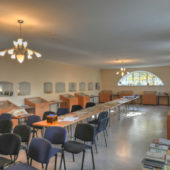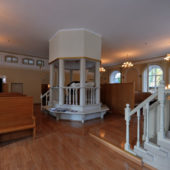Built in 1850, the Daugavpils synaogue has undergone a major renovation, thanks to Keith and Christopher Rothko, children of one the country’s most famous native sons, the artist Mark Rothko
Recently, the Kadisha Synagogue has been restored by the children of painter Mark Rothko, a native of Daugavpils. The restored Synagogue was consecrated on April 11, 2006. Daugavpils Pedagogical Society hires historians who study and teach Judaism, most notably Professor Josifs Steimanis and Boris Vukovich. The wooden house and synagogue of Rabbi Meir Simcha HaKohen are gone, but his grave has been moved from the old cemetery to the new one, since the older cemetery was desecrated by the Nazis and used by the Soviets as a sports field. Rabbi Meir Simcha, the chief rabbi of Mitnagdim, is buried next to his rival and friend The Rogatchover Gaon (Rabbi Yosef Rosen), chief rabbi of the Hassidim. One can only imagine what their souls are disagreeing about, years since they’ve been buried, “all in the name of heaven.”
Jews have lived in Latvia since the late 14th century, but the first Jewish settlement in the area began in the late 1600s. Dvinsk was the original name of the city now called Daugavpils, in Latvia. Situated on the Düna River, at the intersection of two railroads, it belonged to Russia until 1561, when it was annexed to Poland.
According to the census of 1897, out of a total population of 72,231, Jews numbered 32,369. They got along very well with their Gentile neighbors and were prosperous in this town. They were engaged in commerce, industry and manufacturing. Jews governed nearly all of the local trade, including flax, flaxseed and timber. In 1893, according to the census, 300 industrial establishments were owned by Jews and only 99 were owned by Gentiles. There were also 741 Jewish artisans. In 1898, a private investigator reportedly found 4,862 Jewish artisans, which included 2,193 master craftsmen and 1,760 journeymen. The most important Jewish trades at that time were tailoring and shoemaking. There were 32 local factories and workshops (a match factory, tannery, sawmill, button factory, etc.), 100% of which were owned by Jews. Out of the 2,305 people employed at factories, 1,942 of them were Jews.
There were also associations and charitable institutions that aided Jews who were poor, and much money was donated/loaned for this purpose. In 1898, there were 359 Jewish pupils in the Dvinsk school system. In the Jewish schools, there were 401 students. Toward the end of the 19th century their business transactions amounted to ten million rubles annually. In 1913, about half the city’s population of 120,000 was Jewish. Today, there are only approximately 400 Jews, most of whom are elderly, out of approximately 125,000 people.
The Kadisha Synagogue’s exterior is classical, featuring a cream colored façade with paned, arched windows. Ornate stone colored moldings around the windows and other places highlight architectural features and tie in the dark gray wood used for the window panes with the slate gray roof. Inside the light, open prayer room, the cream walls are penetrated by large arched, paned windows. Wood moldings, columns, and the ceiling are in white and the floor is a polished light wood. The white bimah is in the center of the room. A raised platform up several steps features plain wood paneling at the bottom, with eight substantial columns supporting a plain canopy at the top with a horizontal line of gold around the bottom of it. There are two entrances at either side, with a simple balustrade around the sides and up both sets of steps. The Aron Kodesh is against the East wall, on a platform up a few steps, also in white. Double columns with a horizontal line of gold painted at the top and bottom on each side support the top section. This is classical in design, and also features gold detailing, with two tables featuring The Ten Commandments in the center. A deep red velvet Torah curtain with a gold Star-of-David is drawn across it. There are two sets of white stairs with balustrades along the sides of the stairs, as well as the sides and front of the platform. On the floor, in between the two sets of stairs, is a second tivah, with a deep red velvet throw draped over it. Chairs with blue upholstery fill the back half of the sanctuary.
Services are held daily at the Synagogue, Monday through Saturday, plus on High Holy Days, as well as Bar and Bat Mitzvahs.

